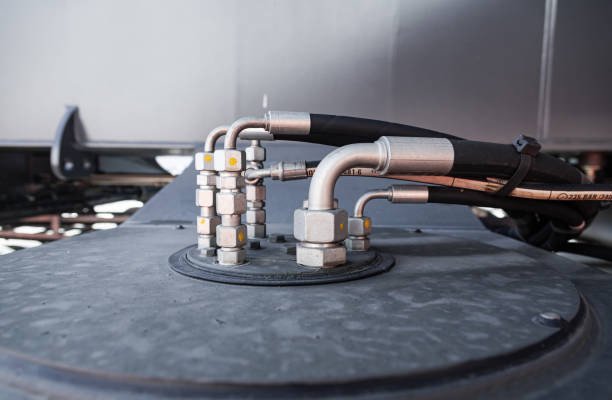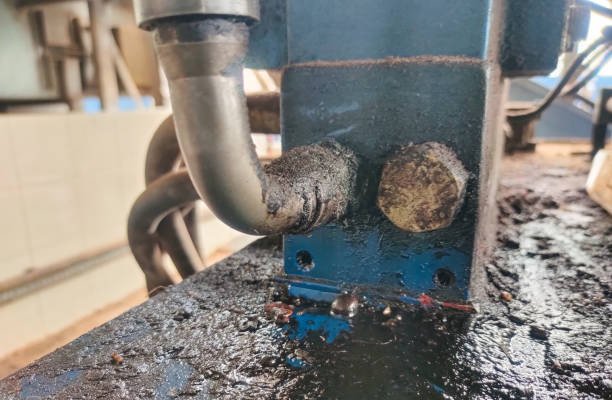Hydraulic couplings are essential components in many industrial and mechanical systems. They serve to connect and disconnect hydraulic systems, transmitting mechanical energy between rotating parts while offering protection against premature wear, vibration, and misalignment. In this comprehensive guide, we’ll explore hydraulic couplings, their types, applications, and benefits, including their role in high-pressure applications, hydraulic hoses, and fluid lines.
1. Introduction to Hydraulic Couplings
What Are Hydraulic Couplings?
Hydraulic couplings are devices used to connect and disconnect hydraulic lines, typically in high-pressure applications, enabling the transfer of energy between rotating components. These couplings help isolate components from each other, ensuring smooth operation by controlling torque and reducing the risk of mechanical failures. In heavy-duty applications, hydraulic couplings ensure reliable power transmission while protecting sensitive parts from premature wear.
How Do Hydraulic Couplings Work?
A hydraulic coupling works by transmitting power from one rotating shaft to another using hydraulic fluid. The coupling typically consists of a pump and a turbine, and the hydraulic fluid passing between these components enables the transfer of rotational energy. Hydraulic quick couplings, such as flat-face couplings, quickly connect and disconnect fluid lines, offering flexibility when attaching and detaching hydraulic hoses under pressure.
Importance of Hydraulic Couplings in Industrial Systems
Hydraulic couplings are crucial in industries where high-pressure applications and efficient power transmission are essential. They enable easy connection and disconnection of hydraulic lines while efficiently controlling pressure and torque, even in challenging operational conditions. For example, flat-face hydraulic couplings prevent leakage and contamination during coupling operations, ensuring a cleaner and safer connection.
2. Types of Hydraulic Couplings

There are several types of hydraulic couplings designed to meet the demands of specific applications. Let’s explore the most common types and their uses in hydraulic systems.
Fluid Couplings
Fluid couplings transmit torque using hydraulic fluid, typically between shafts or pumps. These systems use couplings that ensure smooth startup and high load capacity. Automotive and heavy-duty applications commonly feature them, where high torque and low-speed operation are essential.
Magnetic Couplings
Magnetic couplings use magnetic fields to transmit energy, eliminating the need for direct contact between the two connected components. These couplings are ideal for environments where contamination risks, such as leaks in fluid lines, are a concern. They commonly serve applications where cleanliness is critical, such as in the food and pharmaceutical industries.
Mechanical Couplings
Mechanical hydraulic couplings, including screw-to-connect designs, power systems that require precise transmission, such as heavy-duty machinery. These couplings are ideal for situations where rigid connections are necessary, providing a secure and reliable connection.
Hydraulic Jaw Couplings
Hydraulic jaw couplings feature a flexible element, such as rubber or polyurethane, which absorbs shock and dampens vibrations. These couplings are ideal for applications that require high torque, as they offer flexibility and help prevent misalignment. They are commonly used in systems with hydraulic hoses and fluid lines that experience significant movement.
Diaphragm Couplings
The diaphragm coupling design uses a flexible diaphragm made from high-strength material to transmit torque, making them ideal for high-speed or high-precision applications. These couplings serve industries where precise torque control and minimal vibration are essential, such as in pumps, motors, and compressors.
3. Key Features of Hydraulic Couplings
Torque Transmission
Hydraulic couplings transmit torque smoothly, especially in systems with varying loads. In applications involving hydraulic hoses and fluid lines, hydraulic quick couplings ensure reliable power transmission without sudden shocks or strain.
Vibration Dampening
One of the standout features of hydraulic couplings is their ability to reduce vibrations. This helps to protect sensitive components, especially in high-pressure applications, where the forces involved can lead to premature wear if not properly managed. Couplings like the flat-face hydraulic couplings are especially designed to reduce vibration and maintain operational integrity.
Energy Efficiency
Hydraulic couplings help improve energy efficiency by reducing friction losses and ensuring the efficient transfer of energy between components. This is particularly important in heavy-duty applications, where inefficient energy transfer can lead to unnecessary fuel consumption and operational costs.
Overload Protection
Hydraulic couplings often include overload protection mechanisms, which can absorb shock and prevent damage during unexpected load surges. This protection feature is especially useful in high-pressure applications where hydraulic systems are subject to frequent and unpredictable fluctuations in load and pressure.
4. Advantages of Using Hydraulic Couplings
Smoother Power Transmission
Hydraulic couplings provide smoother power transmission than rigid connections, which is vital for preventing system failures. The ability to transmit power without jerks or sudden impacts is crucial in applications such as manufacturing lines and heavy-duty machinery where consistency is key.
Reduced Wear and Tear
By absorbing vibrations and shocks, hydraulic couplings reduce the wear and tear on connected components, increasing the system’s longevity. This is especially important in systems that experience frequent connection and disconnection of hydraulic hoses, as it minimizes the risk of leaks or other types of damage to fluid lines.
High Load Capacity
Hydraulic couplings are designed to handle high loads, making them ideal for heavy-duty applications such as construction machinery, oil rigs, and manufacturing equipment. Their ability to transmit high torque and withstand significant forces ensures the continued operation of equipment under demanding conditions.
Enhanced System Flexibility
Hydraulic quick couplings, such as push-to-connect and screw-to-connect types, offer exceptional system flexibility. They allow for easy connection and disconnection of hydraulic lines, facilitating quick repairs, replacements, and maintenance. This flexibility is especially valuable in industries where minimizing downtime is crucial, such as automotive manufacturing or field operations.
5. Applications of Hydraulic Couplings
Hydraulic couplings are used in a wide variety of industries. Their versatility and adaptability make them suitable for different applications.
Automotive Industry
In the automotive sector, hydraulic couplings are used in automatic transmissions to enable smooth gear shifting. These couplings, including hydraulic quick couplings, offer a seamless connection and disconnection of fluid lines, which ensures the efficient transmission of power between engine components.
Construction Equipment
Heavy-duty construction machinery relies on hydraulic couplings to ensure the smooth operation of equipment such as excavators, bulldozers, and cranes. Flat-face couplings are commonly used in these applications to ensure high-performance hydraulic connections and reduce the risk of leaks.
Oil & Gas Industry
In oil and gas extraction, hydraulic couplings are indispensable for equipment like pump jacks, drilling rigs, and offshore platforms. These couplings help handle high-pressure applications where reliable connection and disconnection of hydraulic hoses and fluid lines are critical.
Manufacturing and Industrial Automation
Hydraulic couplings are integral in manufacturing systems that require continuous power transmission, such as conveyor belts, press machines, and robotic arms. Couplings that offer quick-release capabilities help reduce downtime during maintenance, making them a key feature in high-demand environments.
Marine and Offshore Applications
Marine vessels use hydraulic couplings to manage torque transfer in propulsion systems. These couplings ensure safe operation under harsh marine conditions and allow for easy connection and disconnection of hydraulic lines for routine maintenance.
6. How to Select the Right Hydraulic Coupling

Choosing the right hydraulic coupling depends on several factors. Consider these important aspects when selecting hydraulic couplings for your system:
Factors to Consider in Selection
- Torque Requirements: Ensure that the coupling is rated for the required torque and load.
- Operating Pressure: Choose couplings designed to handle the pressures involved in your hydraulic system.
- Connection Type: Whether you need screw-to-connect, push-to-connect, or quick-release couplings, ensure you choose the correct connection style.
- Environment: Consider factors such as exposure to moisture, chemicals, or extreme temperatures, which may require specific coupling materials or designs.
Common Mistakes in Choosing Hydraulic Couplings
- Underestimating the coupling size required for high-pressure applications.
- Choosing the wrong connection and disconnection mechanism, such as the wrong type of hydraulic quick couplings.
Hydraulic Couplings Maintenance and Longevity Tips
Regular inspection of couplings for signs of wear, checking fluid lines for leaks, and using the correct coupling size for your system are essential for prolonging the lifespan of hydraulic couplings.
7. Hydraulic Couplings in the Future
Advancements in hydraulic coupling technology are enabling smarter, more efficient systems. The incorporation of digital sensors into hydraulic systems will allow for real-time monitoring of torque, pressure, and fluid levels, which will further enhance the performance and longevity of hydraulic couplings.
8. Conclusion
Hydraulic couplings play an integral role in modern industrial systems, providing reliable, efficient, and flexible power transmission across a wide range of applications. Whether in high-pressure environments, heavy-duty machinery, or critical fluid line connections, hydraulic couplings play a crucial role in preventing premature wear, improving safety, and reducing downtime.
9. Frequently Asked Questions (FAQs)
1. What is the primary function of a hydraulic coupling?
A hydraulic coupling transmits power between rotating shafts using hydraulic fluid, enabling smooth connection and disconnection while controlling torque, vibration, and load.
2. What types of hydraulic couplings are commonly used in the industry?
Common types include fluid couplings, magnetic couplings, mechanical couplings, diaphragm couplings, and hydraulic quick couplers.
3. How do hydraulic couplings reduce maintenance needs?
By reducing premature wear and providing vibration dampening, hydraulic couplings extend the lifespan of machinery, minimizing the need for frequent repairs.
4. What industries use hydraulic couplings?
Hydraulic couplings are used in various industries, including automotive, construction, oil and gas, manufacturing, and marine applications.
5. Can hydraulic couplings handle high-pressure applications?
Yes, hydraulic couplings are designed to handle high-pressure applications, ensuring reliable operation even in challenging environments.
6. How do I select the right hydraulic coupling for my system?
When choosing a hydraulic coupling, consider torque requirements, environmental conditions, coupling size, and the connection and disconnection type (e.g., push-to-connect or screw-to-connect).





